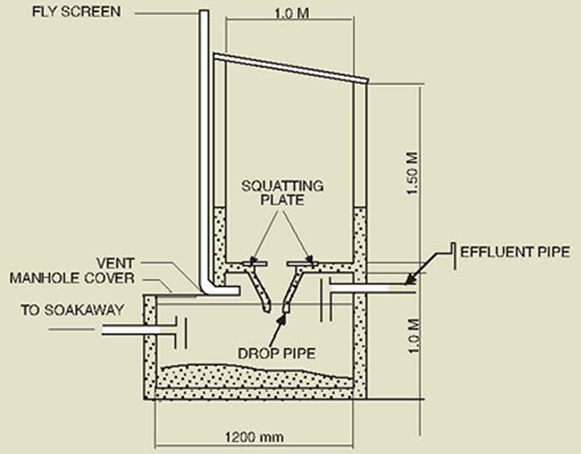Aqua privy
Aqua privy The conventional aquaprivy is essentially a small septic tank located directly below a squatting plate which has a drop pipe extending below the liquid level in the tank to form a simple water seal. To prevent odor, fly and mosquito nuisance in the toilet, the water seal has to be maintained by adding sufficient water per toilet visit to the tank via the drop-pipe to replace any losses. The excreta are deposited directly into the tank where they are decomposed anaerobically similar to a septic tank. A housing or shed is built over the tank. A vent pipe with a fly screen at the top end is attached to the housing. A water-tight tank is desirable to minimize losses. An effluent (overflow) pipe is installed above the level of the drop-pipe.
| Advantages | Disadvantages |
|---|---|
| No danger of clogging by bulky anal cleansing materials. Low odor and insect problems. |
Water seal is often broken particularly during cleaning. Needs small but significant amount of water to maintain water level. |
Capacity
- For a family with 7 users - Capacity: 0,6-0,8 m³ - Filling time: about 6 months.
Costs
- Complete double vault system, freestanding unit US$ 160 (Mexico, 1998).
- Complete double vault system, within the home US$ 35 (China, 2002).
- Operation and maintenance - Negligible.
Applying conditions
- Vaults and chambers are suitable in areas with a hard subsurface and high ground water table.
- The system can be applied in rural, as well as in urban areas. However, it should be noted that, if composted and dehydrated matter cannot be used on site, the need for transport will increase the operation and maintenance costs.
- Processing mixed excreta is only possible in arid climates.
- As with other dry sanitation options, the health risks related to handling of (pre-) treated excreta or faeces have to be taken into consideration.
External links
- General information about Vaults and chambers www.who.int www.gtz.de/ecosan
- South Africa www.csir.co.za
- Australia www.enviro-options.com.au

